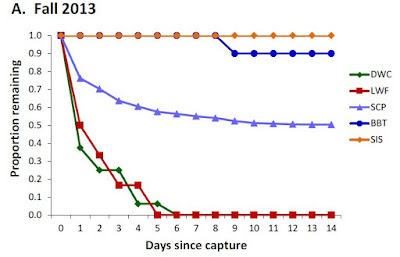Part of my research involves the collection of deepwater fishes from the cold waters of Lake Superior. With the help of Owen Gorman and the folks at the Ashland, USGS, we make sure we have numerous, healthy fish for our experiments.
Our fish are collected via deepwater trawls aboard the USGS research vessel, the KIYI. The fish of interest are brought up from 120 meters (~400ft) and much like scuba divers, rising too quickly to the surface can cause problems. Boyle's law that states that the volume a of gas is inversely proportional to the pressure, meaning that the gasses within fish expand as they move shallower. This internal damage is known as barotrauma (baro=pressure, trauma=damage), and is most apparent in the expansion of the swim bladder and bursting of capillaries within tissues.
 |
| With every 10 meters ascent, the volume of a gas doubles. Here we see a lake trout moving from 20 meters to the surface exhibiting a tripling in the volume of the swim bladder. |
 |
| A siscowet lake trout showing typical barotrauma |
Collected fishes typically show multiple signs of barotrauma including: exopthalmia (bulging eyes), bloated bodies (swim bladder expansion) and tissue damage from ruptured capillaries. There is also internal damage that is less obvious such as the nephron of the kidney rupturing.
While siscowet are hardy and we have not had any mortalities associated with barotrauma, some fish, like deep water coregonines (Kiyi) do not survive once captured.
The graph on the left shows survival of collected fishes in days since captured. Here we see siscowet (SIS) have 100% surival, deepwater sculpin (SCP), 50% and Kiyi (DWC) do not live past 5 days.
In an effort to help alleviate barotrauma, Owen Gorman with the USGS created a hyperbaric vessel to quickly repressurize fish once captured, and then slowly depressurize them. I hleped test the efficacy of this apparatus, known as the HAfF (Hyperbaric Aperatus for Fishes) this fall on Lake Superior.
 |
| HAfF aboard the RV Kiyi |
 |
| Checking the valves before pressurization |
 |
| Decompressed vs. non-decompressed siscowet lake trout |
Collected fishes are slightly anesthetized with MS222, and added to the HAfF (A above). Pressure and mixtures of gasses are monitored from inside the ship via a control panel (B above). We can monitor fish activity with a cameras mounted inside the pressure chambers on the HAfF (C & D above).
Dr. Gorman and I are currently writing up a report for the Great Lakes Fisheries Commision. We have seen marked improvement in the condition of siscowet lake trout since implementing the HAfF. Siscowet that have been decompressed show less tissue damage (A & B right) and show increased activity and feeding sooner. As a comparison, a non-decompressed siscowet lake trout (C & D right) shows obvious signs of barotrauma.

No comments:
Post a Comment